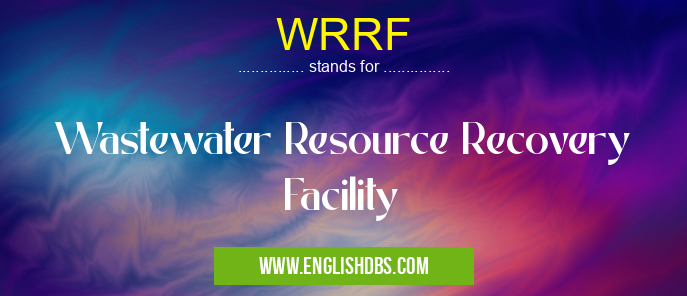What does WRRF mean in UNCLASSIFIED
WRRF is an acronym that stands for Wastewater Resource Recovery Facility. It represents a significant advancement in wastewater treatment processes, transforming wastewater from a waste product into a valuable resource.

WRRF meaning in Unclassified in Miscellaneous
WRRF mostly used in an acronym Unclassified in Category Miscellaneous that means Wastewater Resource Recovery Facility
Shorthand: WRRF,
Full Form: Wastewater Resource Recovery Facility
For more information of "Wastewater Resource Recovery Facility", see the section below.
What is a WRRF?
A WRRF is a wastewater treatment plant that employs advanced technologies to remove pollutants and contaminants from wastewater. Unlike traditional wastewater treatment plants, WRRFs recover and reuse water, nutrients, and energy from the wastewater stream.
How a WRRF Works
WRRFs typically involve the following processes:
- Preliminary Treatment: Removes large solids and debris from wastewater.
- Primary Treatment: Settles out settleable solids, reducing organic matter and suspended solids.
- Secondary Treatment: Uses biological processes to break down organic matter and nitrify ammonia.
- Tertiary Treatment: Advanced processes to remove additional contaminants, such as phosphorus, nitrogen, and heavy metals.
- Disinfection: Kills harmful bacteria and microorganisms.
- Reuse and Recovery: Treated wastewater is reused for various purposes, including irrigation, industrial processes, and groundwater recharge. Nutrients and energy are also recovered and utilized.
Benefits of WRRFs
WRRFs offer numerous benefits over traditional wastewater treatment plants:
- Water Conservation: Recovered water can supplement water supplies, reducing the reliance on freshwater sources.
- Nutrient Recycling: Recovered nutrients can be used as fertilizers, reducing the need for synthetic fertilizers and promoting sustainable agriculture.
- Energy Recovery: WRRFs can generate energy from wastewater, reducing their operating costs and contributing to a greener grid.
- Environmental Protection: WRRFs remove pollutants from wastewater, improving water quality and protecting ecosystems.
Essential Questions and Answers on Wastewater Resource Recovery Facility in "MISCELLANEOUS»UNFILED"
What is a Wastewater Resource Recovery Facility (WRRF)?
A WRRF is a facility that treats wastewater to remove impurities and contaminants before releasing it back into the environment or reusing it for various purposes. It plays a crucial role in protecting public health and the environment.
How does a WRRF operate?
A WRRF typically follows a multi-step process involving physical, chemical, and biological treatment methods. The process includes screening to remove large debris, sedimentation to settle solids, aeration to promote bacterial growth, and disinfection to eliminate harmful microorganisms. Advanced treatment processes, such as membrane filtration or advanced oxidation, may also be employed.
Why are WRRFs important?
WRRFs are essential for managing wastewater and safeguarding public health. They prevent untreated wastewater from contaminating water sources, reducing the risk of waterborne diseases. Additionally, WRRFs contribute to environmental protection by removing pollutants and nutrients that could harm aquatic ecosystems.
What are the benefits of reusing wastewater from a WRRF?
Reusing treated wastewater from a WRRF offers numerous benefits. It can supplement water supplies for non-potable uses such as irrigation, industrial processes, and toilet flushing. Wastewater reuse helps conserve freshwater resources and reduce the strain on water treatment plants. Additionally, it can provide nutrients for agricultural purposes, reducing the need for chemical fertilizers.
How does a WRRF contribute to sustainability?
WRRFs play a significant role in sustainable water management. By treating wastewater and reusing it, they minimize the discharge of pollutants into the environment. Additionally, WRRFs can generate biogas through the anaerobic digestion of sludge, which can be used as a renewable energy source. These efforts contribute to reducing greenhouse gas emissions and promoting a circular economy.
Final Words: WRRFs are innovative wastewater treatment facilities that play a crucial role in water management and resource recovery. By recovering and reusing water, nutrients, and energy from wastewater, WRRFs promote sustainability, protect the environment, and contribute to a more circular economy.
